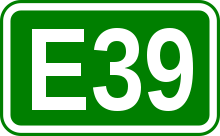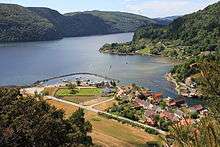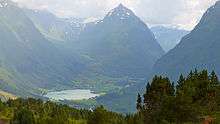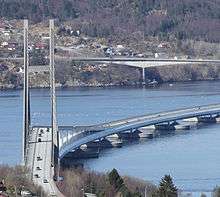European route E39
European route E39 is a European route stretching from Nørresundby in Denmark to Trøndelag in Norway. The main part of the road runs on Norway's west coast, and goes through some of the most beautiful natural scenery in Norway, mountainous, with deep fjords, pristine lakes, as well as major Norwegian cities. E39 itself is the most complex road construction Norway.
- This article is an itinerary.
.svg.png)

Unlike in many European countries, where the European routes are not signed or signed poorly, the European route system is fully integrated into both the Norwegian and Danish road networks; the roads have no other national numbers. This itinerary starts in southern Norway, despite the fact that the south end of the route is actually in Denmark. This is due to convenience; only a tiny part of the route is in Denmark. If you are in Denmark, however, a ferry goes from Hirtshals(the last Danish town on the route) to Kristiansand (the first Norwegian town). If you want to shorten your driving route and stay longer on a ferry, direct crossings between Hirtshals and Bergen or Stavanger are an option.
Understand
Within Norway the route includes seven ferry crossings, more than any other route in Europe. The route crosses most of the great of the many fjords of west Norway, as there are few bridges or tunnels across these wide and deep fjords. Ferries are part of the route and not regarded as a separate means of transport. The road and route sign leads to the dock where vehicles wait for the next departure (first come, first serve principle). Scheduled buses, ambulances and some other special transport has priority on ferries. Most ferries have cafeterias on board with snacks, sandwiches, coffee and in some cases also hot meals. Ferries are comfortable and safe, and welcome pause from driving. Norway has two pontoon bridges, both on E39.
Road standard on the European route E39 is very variable, on some stretches motorway, other places narrow and winding, but mostly standard two-lane undivided. There are several ferry crossings along the route, and several toll booths passed. The next few years will E39 undergo a sharp improvement.
This perhaps Norway's most complex road as it cuts across the complex terrain of steep mountains and deep fjords. Norway's two pontoon bridges are both on this route. Most of the road is two-lane undivided, some more narrow and winding stretches remain, particularly between Lavik (ferry) and Førde. Substantial upgrade is currently (2016) in process and the narrowest points around Sande were replaced with a new segment in 2016. Because of the difficult terrain there is plenty of tunnels (even more after upgrade) and hills. Of Norway's well over 1000 road tunnels, about 100 are on E39. Traffic is generally moderate or light, except long lines of cars leaving ferry and except around major vacations. Drivers must be patient, speeding and overtaking is often risky and gain little.
The most southern part between Kristiansand and Stavanger runs through lowlands and moderate hills. The stretch from Stavanger to Halsa (near Kristiansund) runs across the famous fjords of west Norway.
Parallel alternative routes
- Stavanger-Førde:

- Molde-Trondheim: Routes 62, 70 and E6 via Sunndalsøra and Oppdal to Trondheim
- Førde-Trondheim: Routes 60, 15 and E6 via Stryn and Otta
Prepare
Norwegian roads in general are narrow and slow compared to roads in most European countries. The only motorways in the country are in and around the largest cities, and mostly in the flat eastern parts of the country. E39 is motorway first in the Stavanger-Sandnes conurbation, and later in Bergen. Elsewhere, it is generally two-lane (one in each direction) undivided - sometimes worse and sometimes better.
Keep in mind that long stretches of the road go through desolate areas without towns and petrol stations. It is therefore necessary that your car is in good condition and that you are never close to running out of fuel. While E39 is a relatively busy road, being the main road between Bergen and Sogn og Fjordane, it may still be difficult to get help in case your car breaks down. Cellphone (GSM) coverage is of varying quality, but generally acceptable. There is 3G (UMTS) coverage in most towns above a certain size.
Get in

By plane
Denmark
Norway
This itinerary starts in Kristiansand (not to be confused with Kristiansund). Route E39 runs near the following main airports:
- Kristiansand Airport, Kjevik (KRS IATA)
- Stavanger Airport, Sola (SVG IATA)
- Haugesund Airport, Karmøy (HAU IATA)
- Bergen Airport, Flesland (BGO IATA)
- Ålesund Airport, Vigra (AES IATA)
- Molde Airport (the road runs very close to the airport)
- Kristiansund Airport (KSU IATA)
- Trondheim Airport, Værnes (40 km east of end point of route) (TRD IATA)
Minor airports in Norway:
By train
Railway stations connected to the route:
- Aalborg ((Aalborg-Frederikshavn line, change at Hjørring)
- Hjørring (Hirtshals line, Aalborg-Frederikshavn line)
- Hirtshals (Hirtshals line)
Norway
- Kristiansand (Oslo-Kristiansand-Stavanger line)
- Stavanger (Oslo-Kristiansand-Stavanger line)
- Bergen (Oslo-Bergen line)
- Thamshavn (museum railway)
- Trondheim
- Rauma line terminates at Åndalsnes, 50 km east of the route
Drive



Denmark
- The starting point for The European route E39 is 🌍 Nørresundby outside Aalborg, North Jutland, Denmark. Good highway across the flat countryside.
- 🌍
Hirtshals port. Northern point of the route in Denmark. Continues by

Kristiansand to Stavanger
The southernmost section runs through the lowlands of Vest-Agder and Rogaland. Partly rugged hills, valleys and lakes, but not great elevations.
- 🌍
Kristiansand port. Southern point of route (in Norway) and junction with road E18 and. The route continues by

- 🌍 Flekkefjord. Small town half way between Kristiansand and Stavanger on E39. Flekkefjord sits sheltered in a maze of small fjords, once a popular safe port for sails during storms.
- 🌍 Stavanger. City of Stavanger, regional centre of Rogaland, on the northern end of Jæren flatlands.
- Sidetrip to Jæren and beaches
The low plains of Jæren is the one of the few really flat areas in western Norway and the coast is not protected by skerries and islands. The road along the coast from Egersund to Stavanger airport (Sola) offers a different kind of west Norway, including wide sandy beaches often with generous waves loved by surfers and kiters.
Stavanger to Bergen
This stretch runs across wide fjords and several islands.
There are two major car ferries on this stretch:
- 🌍
Mortavika-Arsvåg car ferry.

- 🌍
Halhjem–Sandvikvåg car ferry.

- 🌍 Bergen. Bergen is the largest city on the route and the capital of the western Norway. Toll to enter city.
Bergen to Byrkjelo

This segment of the road is extremely varied as it runs from the city of Bergen through rugged land, across and along fjords. The small town of Førde is the only notable settlement. The road runs through deep, often gorge-like valleys. There are countless lakes and waterfalls along the road. The road has several steep hills between Bergen and Førde.
This stretch has one floating bridge crossing a fjord just north of Bergen. The wide Sognefjord has a major crossing at Lavik-Oppedal:
- 🌍
Lavik-Oppedal car ferry.

- Sidetrip to Balestrand
Instead of going directly north to Oppedal ferry dock, road E16 to Voss then road 13 over Vikafjell mountain pass and across the great Sognefjord to Balestrand. From Balestrand continue along national tourist route (road 13) via Gaularfjell mountain pass and the romantic land of lakes and waterfalls until junction with E39.
Byrkjelo to Ålesund
Just north of Byrkjelo there is a ferry crossing of the great Nordfjord to Nordfjordeid, about 10 minutes. The road then turns east along the shores of Lake Hornindalsvatn, with more then 500 meters this calm lake is the deepest in Europe and one of the deepest in the world. Most of the lake's volume is under sea level and on average water takes more than 15 years to pass through the lake. At Hornindal (Grodås village) the road turns west towards the alpine landscape of Volda and Ørsta villages, then onto the Festøya-Solevåg ferry for Ålesund. Ålesund and suburbs sits on an archipelago connected to the mainland by short bridges.
- 🌍
Lote-Anda ferry.

- 🌍
Festøya-Solevågen ferry.

- 🌍 Ålesund. Downtown Ålesund with its art nouveau (Jugendstil) buildings after the devastating 1904 fire. Ålesund is also the regional centre with shopping malls and airport. Free.
In the interior around Stryn and Geiranger fjords are wilder and mountains higher than further west. Switch to road 60 at Byrkjelo and climb the hills towards Utvik and Stryn. At Stryn there are two options: The scenic mountain road to Geiranger (and further to Åndalsnes on road 63) or turn west and get back on E39 near Grodås (quick drive through the new tunnel to Volda and Ørsta).
Ålesund to Kristiansund
North of the Ålesund penninsula there is one ferry crossing from Vestnes to Molde:
- 🌍
Molde-Vestnes car ferry.

- 🌍
Halsa-Kanestraumen car ferry.

Instead of driving straight to Molde, a drive through Valldal and Trollstigen to Åndalsnes is one of the highlights in the area. The magnificent valley and wild mountains at Åndalsnes is worth a detour. See more details for Route 63.
- Sidetrip to Atlantic road
From Molde an easy detour is along the very coast where an interestings stretch of road jumps from skerry to skerry on the edge of the atlantic.
Kristiansund to Trondheim (E6 junction)
- 🌍
Junction with E6 (Klettkrysset).

Stay safe

Drivers must be patient. There is little to gain by speeding and overtaking. Norwegian traffic is generally very safe, partly because speed limits are fine tuned to conditions - there is always a reason for reduced speed limits. While some stretches of roads like these may look scary or dangerous, surprisingly few serious accidents happen.
This route has a large number of steep hills, some inside underwater tunnels. Use low gear on the steep descents to avoid overheating brakes.
Some narrow stretches remain particularly between Lavik (ferry dock) and Førde. (Information updated as of June 2016. Road construction is in process at bottlenecks around Vadheim and remaining bottlenecks around Sande.) Where the yellow median line is missing, the road is too narrow for vehicles to pass at full speed. Take it easy, also be prepared to pull over and let oncoming vehicles pass - it is particularly important to let oncoming buses and trucks pass as these are often too big to pull over or have problems reversing.
Winter conditions
- See also: Winter driving
E39 can be a dangerous journey in the winter if the vehicle does not have good winter tires. For trucks, truck trains, buses and other heavy vehicles, it is mandatory in Norway to use mounted snow chains during snowfall. Heavy vehicles must carry chains during the winter months. All drivers should take extra care and must expect extra time. It's better to arrive late than never. A sensible driver has a shovel lying in the vehicle to avoid being stuck. The police and the road authorities have checks during the winter along the entire E39. Irresponsible driving can result in severe penalties.
Go next
From the north end of the E39 European route E6 leads you north to Trondheim in Norway, and continue north furthermore, through Trøndelag and North Norway all the way to the Russian border. Head south over the Dovre mountains to Oslo and the Swedish border.
From the Norwegian south end of E39 in Kristiansand, ferries run to Hirtshals in the South, where the European route E39 continues in Jutland, Denmark. European Route E18 leads you north to Oslo and further east to Stockholm in Sweden.
From the Danish south end the European route E45 leads you south on Jutland, to Aarhus and the German border.